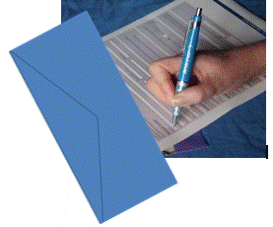I hope you find my writing and business tips and observations useful. My business and blog are dedicated to helping businesses communicate clearly and reach their potential.
Read, subscribe to my newsletter, enjoy!Tash
Writing survey questions
 My earlier post listed some examples of poor survey questions I have come across, so now here are some tips for making your survey questions effective…
My earlier post listed some examples of poor survey questions I have come across, so now here are some tips for making your survey questions effective…
- Know what you are preparing the survey for – and how you will use the results. By planning the results, you will know what questions you need answered and be sure to word them to get the relevant answers. For instance, if you want to know if clients prefer green or blue so you can change your corporate colours, you won’t bother asking “Do you like pink?”
- make each question clearly different – if someone has to read a question two or three times to see why it is different to a previous question, they are likely to give up or answer incorrectly. Be particularly careful to not ask the positive and negative for the same point.
- don’t just copy the same responses for every question. Yes, it is reasonable to give responses such as excellent and poor to some questions, but not if you ask “did the book help you?” A bit of variety is more interesting and makes it more likely people will read each question properly.
- check questions follow on from one to the next, especially if you are using software that provides different questions depending on earlier responses. For example, if someone answers “I don’t have children” to question 1, question 2 really shouldn’t ask “how old are your children?”
- Always provide a response for everyone. It is frustrating for someone who can’t give any of your responses as their answer so always include every option or a way of indicating nothing applies.
- Make sure every question and provided response makes sense. That means read every question/response pair individually. For example, “was the presentation interesting?” works, “was the presentation informative?” works but “was the presentation expectations?” doesn’t work.
- every question must be simple and clear – if the question is too complicated you can’t expect useful results. Simplify questions by
- using simple and short words as much as possible
- divide a long question into two parts if possible
- give responses to choose from rather than an open ended question
- staying to the point – and keeping to your purpose
- keeping all question short – it’s much easier to complicate 12 words than 6!
- Always use good grammar and spelling so people aren’t confused or distracted by your errors.
- Present your survey well so people will actually read and respond to your well written questions!
Ideally, prepare the questions and leave them for a couple of days. Then reread each question to make sure it makes sense and will get the answers you are after. Once you are sure the questions are workable, ask someone else (or a few someone elses) to answer the survey for you and provide feedback on questions they weren’t sure of.
A well written and prepared survey can be a very valuable tool for your business so it is worth putting the time and effort into making it as good as you possibly can.
Running effective surveys
 Aside from the content of the survey itself, it is very important that any surveys or feedback forms are well prepared in other ways.
Aside from the content of the survey itself, it is very important that any surveys or feedback forms are well prepared in other ways.
I just answered a survey that included at least three of the following mistakes and it has left with me with the impression that those business owners don’t care about details or consistency – so why would I trust them with promoting my business (their apparent service)?
So before you make a survey available to your customers, check how it presents and do a test run to see it really does work – better yet, get someone else to do the test run for you.
- Be careful of what you make a compulsory questions/answer. If a compulsory response isn’t included, the person can’t submit their survey and may get frustrated and move on which means you don’t get their feedback. And most people won’t tell you they had this problem, either.
So if you do make a question compulsory to answer, ensure there is an answer for everyone so all can answer – even if one answer is “don’t know”, “prefer not to answer”, “none of the above” or similar.
And if you give a range of answers including ‘other’, make sure that ‘other’ is an acceptable answer. I have done surveys where I can’t submit unless I choose a response instead of ‘other’ – forcing me to choose an inaccurate answer as well as my true comments. - Most small (and even larger) businesses use a third party to run surveys. This generally means the survey appears more professional and can be easier to use – for example, not many businesses can afford the programming to do an online survey each time. While this is a valid practice, minimise the third party as much as possible.
For example, if you complete this business branding survey, which is run on a third party survey site, you will be directed to the host business’s website once you click on ‘submit’. This way, the business itself is being promoted and gains more traffic from people doing the survey. The other option is to let people go to the third party’s homepage once the survey is complete. - Brand the survey as much as possible. If the survey is a serious part of your business, it should continue your brand. That means add a logo, use your corporate colours, use the same style of writing, use your corporate fonts and use relevant images as applicable. You may not be able to make it match your web template or change fonts, for instance, but brand it as much as possible.
- Keep it as short as possible – you probably want responses from a range of people, not just the bored and those who love surveys, and busy people don’t have time for long surveys unless they see a potential benefit from it.
Be careful with the number of questions – if one more question or comment will create a new page, review it. Someone scanning a survey will see there is another page and decide it is too long which would be a pity if the next page was only one question – or worse, if the next page is simply a “thanks for doing our survey” message. - Look at the presentation – is there too much text so it looks complicated or time consuming? Does it look professional or just thrown together? Is there a nice mix of multiple choice answers and written responses, or just written responses? Does it look easy to complete?
Once you are confident you have good questions and a well prepared survey/questionnaire, the next step is to announce and promote it appropriately. Remember that many people won’t fill in the survey just because you want them to – you have to give them a reason to want to do it themselves.
And then make sure you make use of your survey results!
Use your words wisely!
Survey/feedback questions
 It’s unlikely that you have never done a survey or filled in a feedback form about a seminar or such. Unfortunately, it is also unlikely that everyone of those questions you answered was clearly written or easy to understand.
It’s unlikely that you have never done a survey or filled in a feedback form about a seminar or such. Unfortunately, it is also unlikely that everyone of those questions you answered was clearly written or easy to understand.
If you are involved in preparing any surveys/feedback forms, it is important to think carefully about how you ask questions. Obviously, the first step is to know what answers you need – do you really want to know how old people are or just the difference between adults and teenagers?
Here are three recent examples I have come across where the question is not going to get the right responses:
“1. Please list as many soft drink flavours you can think of”
“2. For each flavour, please select A, B or C where A is ‘yes, I knew it was a flavour but forgot it’, B is ‘I didn’t realise it was a flavour’ and C is ‘I’ve never heard of it’. {and then list every flavour whether or not the person listed it in question 1}”
So if you had written orange as a flavour in question 1, how can you select A, B or C for orange in question 2? As it was an online survey and answering was necessary, people would guess an answer so the final results mean nothing.
“Were you satisfied with the course handbook?
- excellent
- very good
- good
- ok
- poor”
The options do not answer the question – was I satisfied can only be answered with yes/no/partially. To offer those choices, the appropriate question would be ‘How would you describe the course handbook?’
“Which of the following have you ever given your child?
- brand X vitamins
- brand Y multi-vitamins
- brand Z mulitvitamins
- brand XY kids calcium”
Personally, I hadn’t given any of them to my child but there was no option to say ‘none of the above’ or even ‘other vitamins’.
So once you have written any questions, go back and read them in order to see if they make sense and are complete. One way to check multiple choice answers make sense it to add each one to the question so “were you satisfied with the course handbook? excellent” quickly shows an issue.
I’ll go through some tips on writing useful questions soon! In the meantime, what poor survey questions have you noticed or had trouble answering?

Recent Comments